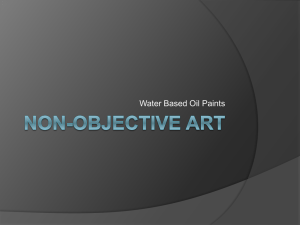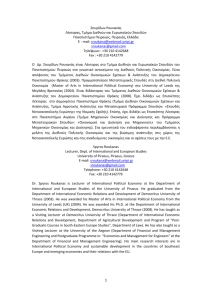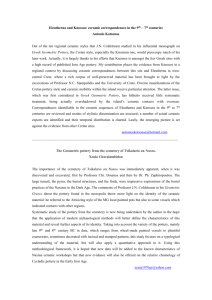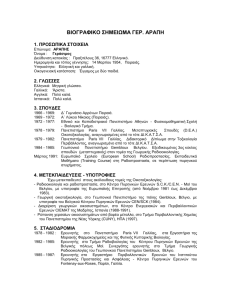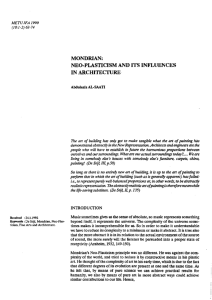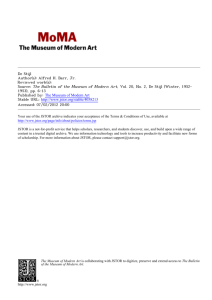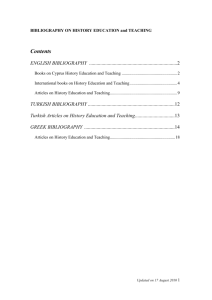Piet Mondrian
advertisement
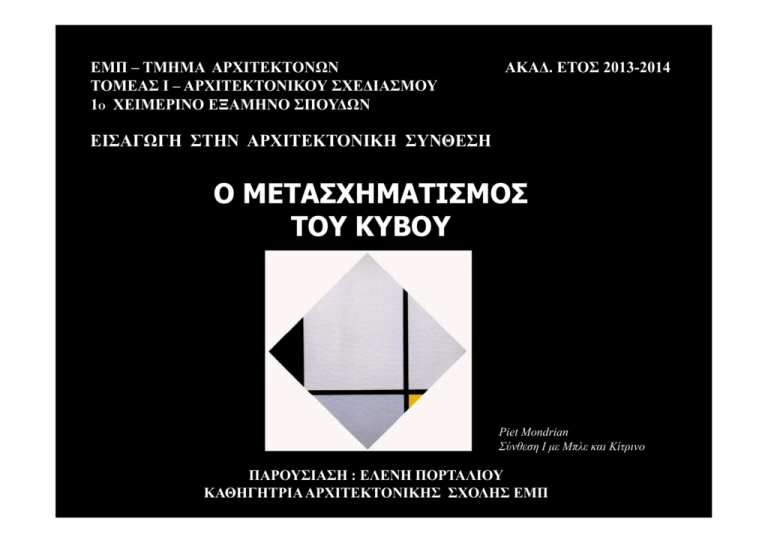
ΕΜΠ – ΤΜΗΜΑ ΑΡΧΙΤΕΚΤΟΝΩΝ ΤΟΜΕΑΣ Ι – ΑΡΧΙΤΕΚΤΟΝΙΚΟΥ ΣΧΕΔΙΑΣΜΟΥ 1Ο ΧΕΙΜΕΡΙΝΟ ΕΞΑΜΗΝΟ ΣΠΟΥΔΩΝ ΑΚΑΔ. ΕΤΟΣ 2013-2014 ΕΙΣΑΓΩΓΗ ΣΤΗΝ ΑΡΧΙΤΕΚΤΟΝΙΚΗ ΣΥΝΘΕΣΗ Ο ΜΕΤΑΣΧΗΜΑΤΙΣΜΟΣ ΤΟΥ ΚΥΒΟΥ Piet Mondrian Σύνθεση Ι με Μπλε και Κίτρινο ΠΑΡΟΥΣΙΑΣΗ : ΕΛΕΝΗ ΠΟΡΤΑΛΙΟΥ ΚΑΘΗΓΗΤΡΙΑ ΑΡΧΙΤΕΚΤΟΝΙΚΗΣ ΣΧΟΛΗΣ ΕΜΠ Το θέμα αυτό αναδεικνύει, με τον πιο απλό και εμπειρικό τρόπο ότι η αρχιτεκτονική σκέψη είναι πάντα συνθετική. ή Βασίζεται ζ σε συνεχείς χ ςμ μετασχηματισμούς, χημ μ ς που προϋποθέτουν ρ αποφάσεις φ ς γγια να συγκεκριμενοποιηθούν, στο σκέπτεσθαι δια του πράττειν και στο δοκιμή και λάθος. Το δεύτερο θέμα εισάγει με συστηματικό τρόπο στα μέσα παράστασης /αναπαράστασης του χώρου. Αναφέρεται συγκεκριμένα στον μετασχηματισμό ενός κύβου διαστάσεων 30Χ30Χ30εκ., 30Χ30Χ30εκ που θα πραγματοποιηθεί με την αφαίρεση τμημάτων των επιφανειών των πλευρών του και την επανατοποθέτησή τους στον αρχικό κύβο σε διαφορετικές θέσεις. Η τελική κατασκευή θα προκύψει από την ανασύνθεση του κύβου. Η τοποθέτηση της κατασκευής θα γίνει σ’ ένα βασικό επίπεδο αναφοράς (εισαγωγή στην έννοια της βαρύτητας και της ισορροπίας της κατασκευής) και θα συσχετιστεί μ’ ένα καρτεσιανό σύστημα αναφοράς. Εκπαιδευτικοί στόχοι της άσκησης • Κατανόηση της τρισδιάστατης κατασκευής και των μέσων αναπαράστασης. Εισαγωγή στη χρήση απλών υλικών και των οργάνων σχεδίασης στη σχέση τους με τον αρχιτεκτονικό ό σχεδιασμό. δ ό Κατανόηση της σημασίας του σκίτσου και της μακέτας στην αναλυτική διερεύνηση του χώρου και στη συνθετική διαδικασία. • Μεταφορά φ ρ από τον χχώρο ρ στην η τρισδιάστατη ρ η (μ (μακέτα)) και στη η δυσδιάστατη η ((σχέδιο) χ ) απεικόνιση. Σχεδιάζω αυτό που βλέπω. • Διερεύνηση των συνδυασμών και των παραλλαγών που προκύπτουν από διαφορετικές σχέσεις ενός επιπέδου με ένα άλλο επίπεδο. • Κατανόηση Κ ό της σημασίας ί του επιπέδου έδ ως «διαχωριστικού δ ύ στοιχείου» ί στο χώρο. ώ • Κατανόηση της σημασία του ανοίγματος. ΓΕΩΜΕΤΡΙΑ - ΚΑΝΑΒΟΣ ΚΑΙ ΜΕΤΑΣΧΗΜΑΤΙΣΜΟΙ ΤΟΥ ΚΥΒΟΥ ΡΩΣΙΚΗ ΠΡΩΤΟΠΟΡΙΑ Ορισμένα από τα έργα που παρατίθενται είναι από τη συλλογή Γ. Κωστάκη όπως εκτέθηκε στην Εθνική Πινακοθήκη στην Αθήνα Kasimir Malevich, (1878-1935) Russian painter and designer, with Mondrian the most important pioneer of geometric abstract art. Born near Kiev; trained at Kiev School of Art and Moscow Academy of Fine Arts; 1913 began creating abstract geometric patterns in style he called suprematism; taught painting in Moscow and Leningrad 1919-21; published book, book The Nonobjective World (1926), (1926) on his theory; first to exhibit abstract geometric paintings; strove to produce pure, cerebral compositions; famous painting White on White (1918) carries suprematist theories to absolute conclusion; Soviet politics turned against modern art, and he died in poverty and oblivion. He began working in an unexceptional Post-Impressionist manner, but by 1912 he was painting peasant subjects bj t in i a massive i `tubular' `t b l ' style t l similar i il to t that th t off Léger Lé as well ll as pictures i t combining bi i the th fragmentation f t ti off form of Cubism with the multiplication of the image of Futurism (The Knife Grinder, Yale Univ. Art Gallery, 1912). Malevich, however, was fired with the desire `to free art from the burden of the object' and launched the Suprematist movement, which brought abstract art to a geometric simplicity more radical than anything previously seen. He claimed that he made a picture `consisting of nothing more than a black square on a white field' as early as 1913, but Suprematist paintings were first made public in Moscow in 1915 and there is often difficulty in dating his work. (There is often difficulty also in knowing which way up his paintings should be hung, g, pphotographs g p of earlyy exhibitions sometimes pproviding g conflictingg evidence.)) Malevich moved away from absolute austerity, tilting rectangles from the vertical, adding more colors and introducing a suggestion of the third dimension and even a degree of painterly handling, but around 1918 he returned to his purest ideals with a series of White on White paintings. After this he seems to have realized he could go no further along this road and virtually gave up abstract painting, painting turning more to teaching, teaching writing, writing and making three-dimensional models that were important in the growth of Constructivism. In 1919 he started teaching at the art school at Vitebsk, where he exerted a profound influence on Lissitzky, and in 1922 he moved to Leningrad, where he lived for the rest of his life. He visited Warsaw and Berlin in 1927, accompanying an exhibition hibiti off his hi works k andd visited i it d the th Bauhaus. B h I the In th late l t 1920s 1920 he h returned t d to t figurative fi ti painting, i ti b t was outt but of favor with a political system that now demanded Socialist Realism from its artists and he died in neglect. However, his influence on abstract art, in the west as well as Russia, was enormous. Kasimir Malevich Black Circle, 1923-29 Black Cross, 1923 Black Square, 1923-29 Red Square: Painterly Realism of a Peasant Woman in Two Dimensions Four squares, 1915 Kasimir Malevich (από τη συλλογή Γ. Κωστάκη) Μαύρο Ορθογώνιο Κόκκινο τετράγωνο προσχέδια Kasimir Malevich (από τη συλλογή Γ. Κωστάκη) Μελέτες σουμπρεματικής τοιχογραφίας για εσωτερικό χώρο, 1920-21 Kasimir Malevich Black Square and Red Square,1915 Self-Portrait in Two Dimensions, 1915 Composition, 1915 Kasimir Malevich Aeroplane Flying, 1915 Suprematism Composition, 1916 Ivan kliun (από τη συλλογή Γ. Κωστάκη) Σουπρεματικές μελέτες χρώματος και φόρμας, 1917 Lyubov Popova (από τη συλλογή Γ. Κωστάκη) προσχέδια Painterly Architectonics, 1917 Painterly Architectonics. Black, Red,Gray, 1916 (από τη συλλογή Γ. Κωστάκη) Ίλια Τσάσνικ, Σουμπρεματικός σταυρός, 1923 Πιότρ Μιτουριτς, Δέκα κυβοι, 1919-21 (από τη συλλογή Γ. Κωστάκη) Νικολάι Λαντόφσκι , Μοντέλο για κατασκευαστική δομή, 1921 Νικολάι Λαντόφσκι, Παράδειγμα συνθετικής δομής, 1921 DE STIJL Piet Mondrian, (Pieter Cornelis MondriaanMondriaan 1872–1944) 1872 1944) Dutch painter, who carried abstraction to its furthest limits. Through radical simplification of composition and color, he sought to expose the basic principles that underlie all appearances. He developed "neoplastic" aesthetic involving reduction of paintings to elements of straight lines, primary colors,, noncolors. Mondrian became the most radical abstractionist artist of his era. After studying cubism, Mondrian’s work became increasingly nonrepresentational, until his compositions such as Composition with Red, Red Yellow, Yellow and Blue above, above which consists of flat planes of the three primary colors broken by black lines. In this new art form (Neoplasticism) Mondrian’s goal was to eliminate all traces of representation in favor fa or of balanced compositions of primary primar color and vertical and horizontal lines. In other word, Neoplasticism represents the absolute elements—primary colors and vertical and horizontal lines—that underlie all appearances. He used vertical and horizontal lines to show that the canvas was a place consisting of right angles. His achievement of balance between unequal parts affected the direction of art, g The movement associated architecture,, and industrial design. with Mondrian’s style was named "de Stijl," after the magazine he formed in 1917. Composition with Red, Red Yellow and Blue, Blue 1937-1942 Piet Mondrian Composition with Black, Red, Gray, Yellow, and Blue 1874 Blue, Composition with Yellow, Black, Blue, Red, and Gray 1921 Gray, Piet Mondrian Composition No 2 Opposition Of Lines: Red And Yellow Composition Piet Mondrian Composition with Color Planes and Gray Lines, 1918 Composition with Grid VII, 1919 Piet Mondrian Broadway Boogie-Woogie, 1942-1943 New York City, 1941-1942 victory boogie-woogie, 1942-1944 Theo van Doesburg ( 1883 – 1931 ) Dutch artist and theorist (born Christian Küpper), founder of De Stijl. Self-taught, the maverick van Doesburg initially detested the avant-garde and pursued naturalism. In response to the ideas of Apollinaire and Kandinsky , however, his outlook altered, and by 1915 he was fully converted to abstraction. As much a theorist and critic as practitioner, he became acquainted with many avantgarde Dutch artists over the following years, including Mondrian , culminating in the founding of De Stijl in 1917 . As editor of the periodical of the same name until 1928 , van Doesburg was the linchpin of the group, and almost its sole representative after 1924 . De Stijl included nearly as many architects as artists, artists reflecting van Doesburg's concern with the integration of art and architecture. He taught for a short period at the Bauhaus, and collaborated on numerous architectural projects. His paintings share the rectilinearity of Mondrian's as in Counter-Composition, although he later advocated a theory of Elementarism which he considered a correction of Mondrian's Neo-plasticism. p His attempt p to re-establish De Stijl in 1931 was forestalled by his untimely death. Arithmetic Composition, 1930 Theo van Doesburg Counter Composition VI 1925 Composition weiss black Composition in Gray Theo van Doesburg Poster , 1920 Poster Theo van Doesburg Counter CompositionV p , 1924 Counter-Composition XV, 1925 Simultaneous Counter-Composition, p , 1929-30 silkscreen Composition p XXII CompositionV Theo van Doesburg Cornelis van Eesteren, Maison d’Artiste, 1923 Architecture analysis Gerrit Rietveld Schröder House Utrecht , 1924 R d andd Blue Red Bl Chair Ch i , 1917


